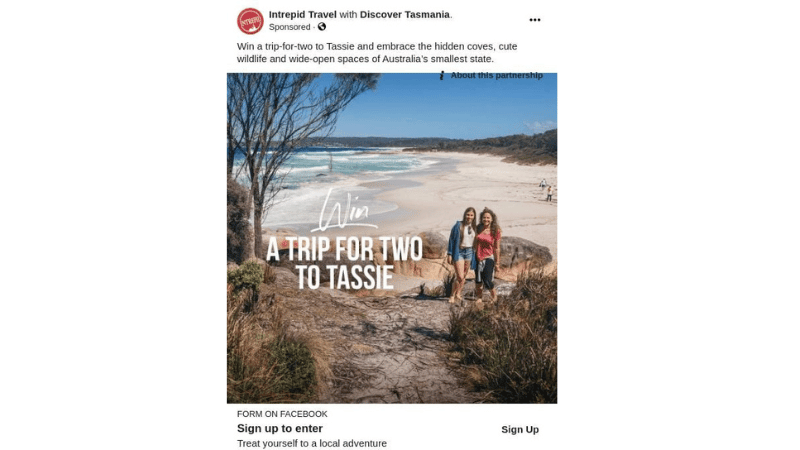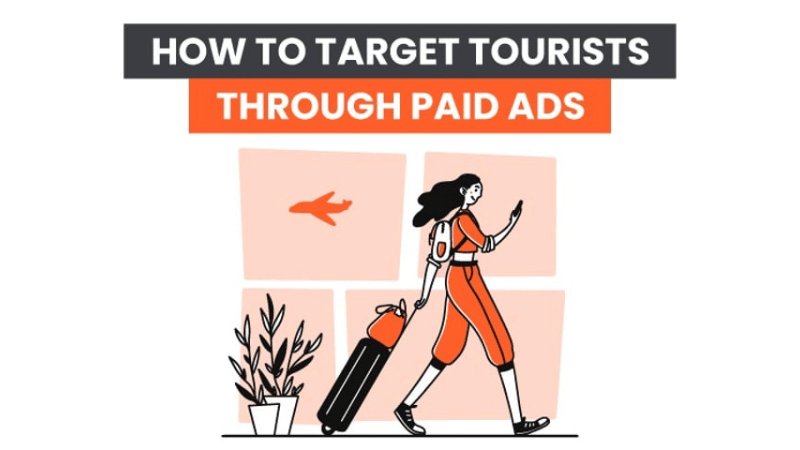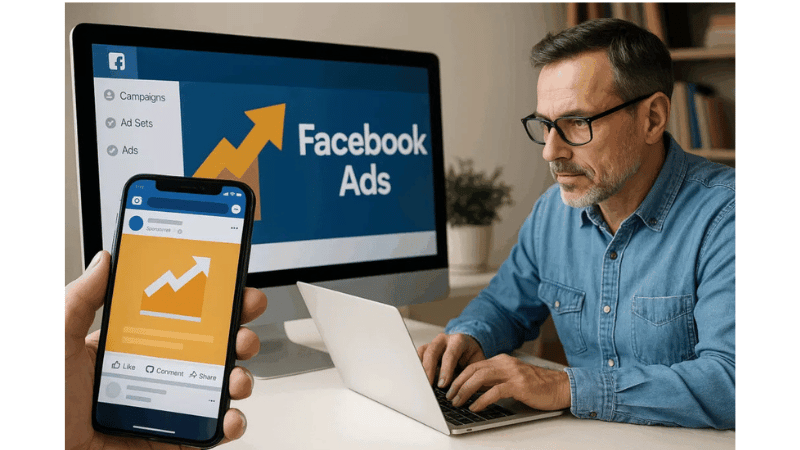Traveling now is not just about “packing your bags and leaving”; it’s a whole journey of choosing tours, reading reviews, and hunting for deals right on Facebook. This is precisely why Facebook Ads for Travel Agencies become an extremely powerful tool to rapidly drive customer traffic. Not only does it help save costs, but Facebook Ads for Travel Agencies also unlock the opportunity to accurately target the needs of each customer segment, from backpacking enthusiasts to clients seeking premium resort packages. When advertising is leveraged effectively, companies not only increase steady booking volume but also build a reputable brand image, creating a sustainable competitive advantage in a market that is constantly evolving.
Facebook advertising: The key for travel agencies
Traditional advertising is often costly and difficult to measure for effectiveness. This is why Facebook Ads has become the “golden key” for travel agencies. This platform not only provides the ability to reach the right potential customers but also allows businesses to control their budget, optimize costs, and significantly increase ROI (Return on Investment).

Where travelers are always online
One of Facebook’s strengths is its ability to connect billions of users, including the segment of travel enthusiasts. They are constantly online searching for new destinations, checking out friends’ experiences, or simply scrolling through their newsfeed to “gaze” at beautiful pictures. This means travel agencies can easily reach customers right when they are planning a trip.
With targeting tools based on interests, behaviors, and habits, businesses can display beach tour ads to a group of people interested in surfing, or promote a luxury resort combo to those who frequently check in at high-end resorts. In other words, instead of broadly “throwing” ads, Facebook Ads allows travel agencies to appear at the right time, in the right place, and meet the exact need, an enormous advantage in the journey toward closing a booking.
Creating brand identity from the start
Beyond just selling tours, travel businesses need to create a brand identity that customers will remember long-term. Facebook Ads supports this through various engaging ad formats like video, carousel, slideshow, etc. A short clip capturing customers’ happy moments during a trip, or a beautiful photo album from popular destinations, can quickly create positive emotions and build trust. When a brand consistently appears and is associated with wonderful experiences, customers will gradually consider it their preferred option when they need to travel. Building the brand early on also helps the business avoid becoming entirely dependent on promotions, as customers choose tours based more on reputation and trust than on the lowest price.
Cost advantage compared to traditional channels
One of the biggest concerns for travel agencies is marketing costs. Previously, promotion relied on TVCs, print media, or event organization—channels that were expensive and difficult to measure for effectiveness. Facebook Ads have completely changed the game. Businesses can start Facebook ads with a small budget, even just a few hundred thousand VND, to test content and customer segments. Based on the results, they adjust the campaign to optimize every dime spent.
Furthermore, Facebook provides detailed reports on the number of clicks, conversion rates, cost per booking, etc. From this, the travel agency can easily know which ads are effective and which budget portions need to be cut. When compared to the cost of an advertisement in a magazine or a travel fair, Facebook Ads clearly offer superior flexibility and advantage for both large and small businesses.
Formula for running attractive tourism ads
For a travel advertising campaign to truly take off on Facebook, a company needs more than just creative ideas; it must also have a smart deployment strategy. Today’s travelers access information very quickly; they easily scroll past countless ad variations without stopping if the content isn’t compelling enough.

Highly effective tour remarketing
One of the most powerful “weapons” in Facebook advertising is remarketing. For the travel industry, remarketing is particularly suitable because customer behavior often involves multiple stages: learning about tours, comparing prices, checking reviews, and then making a decision. Often, they have visited the website, looked at a few tours, but exited without booking. This is when remarketing demonstrates its strength.
By installing the Pixel and creating Custom Audiences, the business can “follow” people who have previously visited the site or interacted with posts. For example, a customer who just viewed a Phu Quoc tour then sees an attractive ad on Facebook with a special price or dazzling island photos; there is a high probability they will return and make a decision faster. Remarketing not only increases the conversion rate but also helps the travel agency save costs by accurately targeting customers who already have an existing need.
Experiential videos that touch emotions
In the world of travel advertising, visuals and emotions are always the “key” that makes customers want to pack their suitcases immediately. A purely text-based post can hardly convey the full beauty of a journey, but a short 15–30 second video can. Facebook Ads allows businesses to easily push experiential videos to thousands of people at a reasonable cost.
Imagine a short clip filmed by a drone showcasing the panoramic view of Ha Long Bay on a misty morning, interspersed with scenes of guests enjoying seafood and laughing happily on a cruise. Such moments strike the viewers’ emotions, making them not only like the video but also immediately message to inquire about tour prices. Video can also tell a story: the journey from the customer’s departure to the exciting experiences, culminating in a satisfied smile. Once emotions are touched, the click-through rate and booking rate will surge. This is why large travel agencies today are heavily investing in video content for Facebook Ads.
Lead forms for quick lead generation
Besides remarketing and experiential videos, lead forms are also a crucial part of the formula for attracting tourists. The biggest advantage of the lead form is convenience: customers only need to click a button, and contact information like name, email, and phone number is automatically pre-filled from Facebook. This reduces steps, making it much easier for users to leave their information compared to having to go to a website and fill out a long form.
For travel agencies, lead forms are extremely useful when running ads for short tours, flight + hotel combos, or high-season promotions. For instance, when launching a “Da Lat 3D2N Tour with 20% off” program, with just a simple form: “Register now to get the offer,” the business can quickly gather hundreds of potential customers in a few days. This data is then followed up by the sales team for consultation, closing the deal within the week.
Another plus is that the lead form allows for initial audience filtering. The company can ask supplementary questions like “How many people are in your group?” or “When do you plan to travel?” to segment customers, avoiding time wasted calling those who are not truly interested. This is a way to shorten the journey from ad to booking while reducing the cost per lead acquired.
Smart ad cost reduction
Although it’s known that Facebook Ads offers the opportunity to reach millions of potential customers, if not optimized, the cost will be “burned” with little return. What a business needs is not just to run ads, but to run them smartly, so that every dollar in the budget brings value.

A/B Test to find the “Star”
Not all ad variations have the same appeal. A check-in image at a clear blue beach might generate a massive number of clicks, while a lengthy tour poster goes unnoticed. Therefore, A/B testing is a mandatory tool to use if you want to spend responsibly. A business can simultaneously test two ad variations with the same small budget to see which one truly deserves scaling. When the data shows which ad has a higher CTR and a cheaper cost per lead, you should confidently scale the budget for that variation. This method is both economical and helps avoid “wasting money” on ineffective ads.
Lookalike audiences to expand the pool
One of the secrets to cutting costs while increasing efficiency is leveraging Lookalike Audiences. Instead of targeting too broadly and spending money displaying to uninterested people, a travel agency can create a Lookalike Audience based on a list of customers who have previously booked a tour, filled out a form, or messaged the Fanpage. Facebook will automatically find people with similar behaviors, meaning their likelihood of being interested in your tour is much higher. As a result, the ad budget is used in the right place, the cost per result decreases, and the conversion rate significantly increases.
Cut “money-burning” costs
Many businesses are hesitant to “cut” due to fear of reducing effectiveness, but in reality, poor-performing campaigns are the reason the budget is wasted. The smart approach is to regularly review key metrics like CTR, CPC, and CPA to identify which ad groups are consuming money without generating bookings. When you see a campaign with an abnormally high CPC or a very low conversion rate, don’t hesitate to stop it immediately. Aggressively eliminating weak ads will help you save the budget for campaigns that truly bring profit, thereby significantly increasing the overall ROI while reducing costs.
Accurately measuring return on investment (ROI)
A successful ad campaign is not just about getting many views or interactions; most importantly, it’s about the Return on Investment (ROI) it brings to the business. In the travel industry, where customer behavior changes rapidly with seasons and trends, accurately measuring ROI helps the company know how much real value each dollar spent generates. By tracking specific metrics, a business can optimize ads, cut unnecessary costs, and increase profit sustainably.
Monitor CTR and CPC metrics
CTR (Click-Through Rate) and CPC (Cost Per Click) are two fundamental metrics that need to be monitored regularly. CTR reflects the attractiveness of the ad, while CPC indicates how much the business is spending to attract one visit. If the CTR is low, the image or ad content may not be eye-catching enough; if the CPC is too high, the audience segment or ad format needs adjustment. Analyzing these two metrics simultaneously helps identify which ads are truly effective and bring in many potential customers at an optimal cost.
Measure the value of each booking
Not all clicks are of equal value; the critical factor is how many clicks actually convert into a booking. Measuring the Cost per Booking allows the business to know the actual cost of closing a customer. In the travel industry, each booking can bring in high revenue, but if the advertising cost is too high, the ROI will still be low. Installing proper tracking (like the Facebook Pixel or Google Tag Manager) will help the business accurately monitor the process from when the customer clicks the ad until they complete payment, thereby clearly assessing campaign effectiveness.
Adjust campaigns according to travel seasons
The travel industry is highly seasonal, so measuring ROI must be accompanied by adjusting campaigns for each period. During the peak season, ads can focus on pushing bookings with a larger budget; during the off-season, the budget can be reduced, shifting focus to remarketing ads to retain old customers. Flexible adjustment helps the business avoid “wasting money” during periods of low demand while optimizing ROI during the peak season when customers have stronger needs.
Frequently Asked Questions
It depends on the strategy, but a travel agency should run ads year-round. During the peak season, increase the budget to maximize bookings; during the off-season, switch the goal to remarketing, nurturing content, and brand building. This way, the business saves costs while maintaining a consistent presence, preventing customer loss to competitors.
It is different. In the travel industry, the value of each booking is often high, but the customer’s decision-making cycle is also longer and more complex. A customer might view an ad today but only book a tour weeks later. Therefore, businesses need to use multi-touch attribution tools to accurately determine which ads contributed to closing the sale, rather than just accounting for the last click.